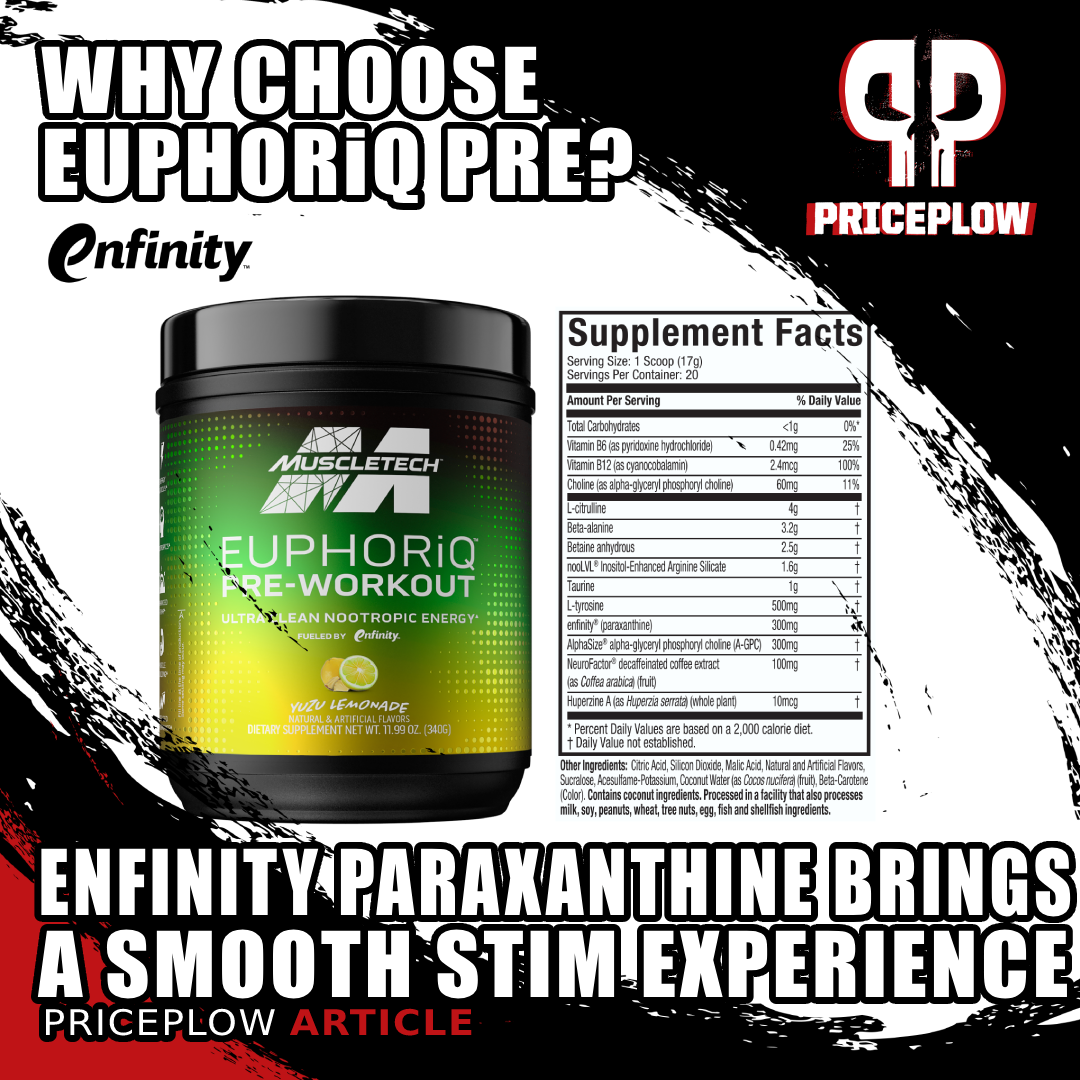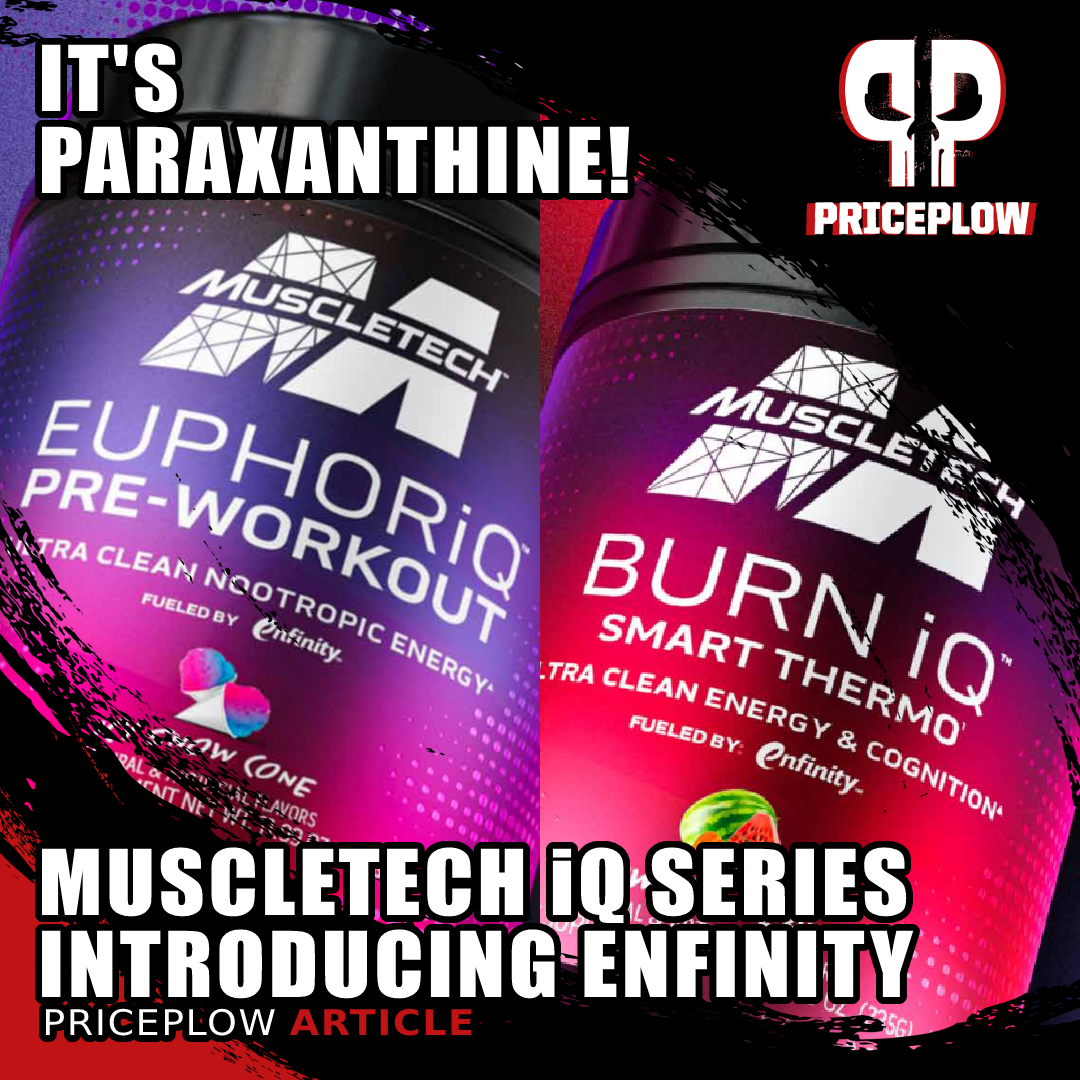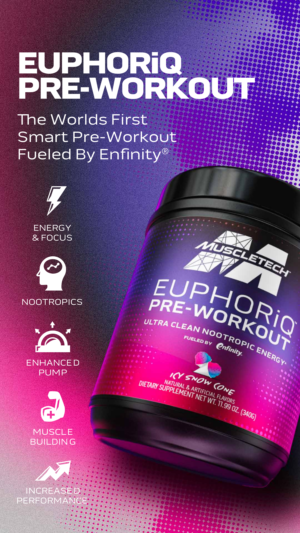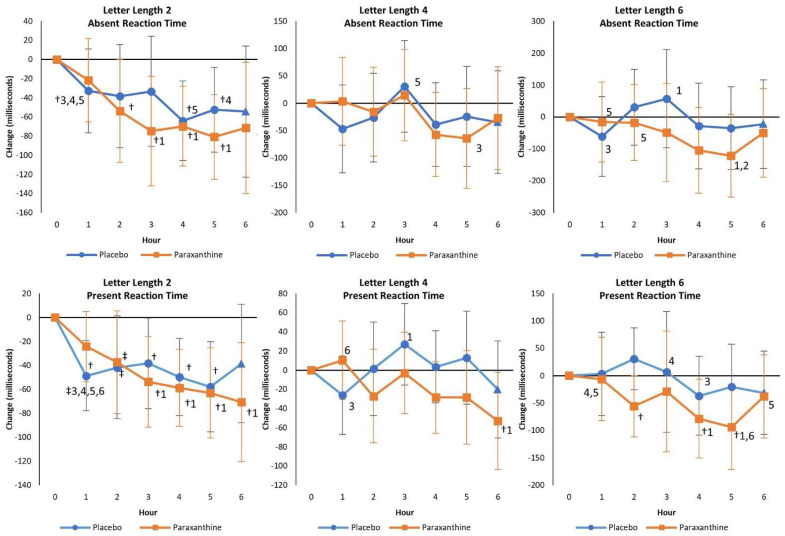In 2023, something really big happened. MuscleTech launched the EuphoriQ pre-workout — the first mass-market supplement containing paraxanthine, a stimulant that replaces (it's actually the main metabolite of caffeine).

Some people get absolutely wrecked by caffeine, and using genetic research, this article explains why. The solution? MuscleTech EuphoriQ pre-workout, which instead uses enfinity paraxanthine.
We brought Shawn Wells and Raza Bashir onto Episode #072 of the PricePlow Podcast to explain the story behind the ingredient (which is named "enfinity"), and a big part of the ingredient's success is based on genetic variations in caffeine metabolism across individuals.
So today, we're talking about why it makes sense to opt for this paraxanthine-containing pre-workout rather than the usual caffeine-containing formulas -- especially for certain individuals.
Paraxanthine: The primary caffeine metabolite... without the other negatives attached
Paraxanthine is a methylxanthine stimulant, just like caffeine, which is its predecessor chemical substrate. The two stimulants have virtually identical effects on physiology and cognition—although paraxanthine is actually slightly superior to caffeine in certain respects, especially if you're a "slow caffeine metabolizer", as we'll explain in this article.
No matter who you are, your body will metabolize paraxanthine faster than caffeine. Paraxanthine's shorter half-life allows for more targeted use, and is suitable where caffeine is not. You can get the desired effect and the associated athletic performance benefits closer to your workout window.
But even better, you'll sidestep the most toxic and longest-lasting caffeine metabolite, theophylline, which seems to be what truly wrecks slow caffeine metabolizers who can't use the stimulant if they plan on sleeping.
Let's get into why paraxanthine is a huge value add in MuscleTech's EuphoriQ, but first, check PricePlow's availability and sign up for our MuscleTech news and deal alerts:
MuscleTech EuphoriQ Pre-Workout – Deals and Price Drop Alerts
Get Price Alerts
No spam, no scams.
Disclosure: PricePlow relies on pricing from stores with which we have a business relationship. We work hard to keep pricing current, but you may find a better offer.
Posts are sponsored in part by the retailers and/or brands listed on this page.
This area is reserved for Team PricePlow's upcoming Research Study video.
Subscribe to our channel and sign up for notifications so you catch it when it goes live!
Paraxanthine: A Shorter Half-Life than Caffeine
As we wrote in our flagship article, Paraxanthine: Caffeine's Major Metabolite for Laser-Targeted Energy, enfinity's big value proposition over caffeine is the superior pharmacokinetic profile.

Paraxanthine is the primary metabolite of caffeine, providing most of caffeine's beneficial effects. Now you can take it directly with enfinity!
When you ingest caffeine, roughly 70-80% of it is metabolized into paraxanthine,[1,2] with most of the rest metabolizing into theobromine and then a smaller fraction into theophylline.
Of these, paraxanthine has the shortest half-life: The body clears 50% of ingested paraxanthine in about 3 hours — compared to 4 hours for caffeine, 6 hours for theobromine, and 7 hours for theophylline.[1]
CYP1A2 Dependencies
This matters because one's expression of CYP1A2, the enzyme that converts caffeine into its metabolites via demethylation, varies considerably with individual genetics.[3]
Genetic traits are produced by combinations of alleles. When it comes to CYP1A2 variations, substituting allele C for allele A at position 163 (rs762551) on the CYP1A2 gene decreases inducibility of the enzyme, as reflected by measurements of urinary caffeine-to-metabolite ratios. It has three possible combinations:[3]
- A/A: Fast metabolizer
- A/C: Intermediate metabolizer
- C/C: Slow metabolizer
As it turns out, it matters a lot which category you fall into. Caffeine's half-life for any given individual ranges from 1.5 hours to 9.5 hours[4] — a difference that can quite obviously completely make or break your relationship with the drug.
According to epidemiological data, the 90th percentile caffeine intake in the U.S. is 380 mg/day.[5]
Fast vs. Slow Metabolizers: A massive difference
Fast metabolizers whose caffeine half-life is 1.5 hours could ingest this amount at noon and have only about 6 milligrams of caffeine left in their systems by 9 p.m., which is a pretty reasonable bedtime. And, obviously, such a small quantity of circulating caffeine would have a negligible impact on sleep.
A slow metabolizer, on the other hand, assuming their half-life is 9.5 hours, would still have about 190 milligrams (half the initial amount) left in their blood at 9 p.m. Since the typical cup of coffee contains somewhere between 100 and 200 milligrams of caffeine, that's basically like drinking a 6-to-8-ounce serving immediately before bed. That will obviously have a massive impact on sleep quality and duration.
If you've met someone who gets absolutely wrecked by a simple cup of coffee -- even early in the morning -- there's a great chance they're a de-facto "C/C" slow metabolizer.
Unsurprisingly, research has found that daily coffee drinking can increase the risk of high blood pressure in slow metabolizers, but not in fast metabolizers.[6]
If you think that's unfair, wait until you hear this: In fast metabolizers, caffeine can even decrease the risk of hypertension. This was demonstrated in a study where urinary caffeine-to-paraxanthine ratio positively correlated with blood pressure levels.[7]
Products containing enfinity work around this, but realize that paraxanthine is also metabolized by CYP1A2. However, paraxanthine's lower half-life can make a big difference for slow metabolizers (i.e., if your caffeine half-life is 9 hours, your paraxanthine half-life will be only 6.75 hours).
While slow metabolizers won't want to take EuphoriQ before bed, medium and fast metabolizers are more likely to get away with it in their evening workouts. And, we are seeing that "C/C" slow metabolizers can get away with taking enfinity around lunchtime and still make it to sleep!
The bigger issue – caffeine's other metabolites
Caffeine is only one part of the overall picture that slow metabolizers must consider. Remember, caffeine's other two metabolites, theobromine and theophylline, actually have longer half-lives: 6 and 7 hours, respectively![1]

MuscleTech has revealed their new iQ Series of supplements, and it will include a new stimulant -- paraxanthine -- named enfinity. Learn how this lineup will forever revolutionize the entire energy industry
A back-of-the-envelope calculation shows that if your individual caffeine metabolism is ~9 hours, your theobromine half-life will be 13.5 hours, and your theophylline half-life will be 15.75 hours.
While most of the caffeine you ingest gets converted to paraxanthine, the second most prevalent metabolite is theobromine, and the actual data is showing that more caffeine gets metabolized into theobromine than Wikipedia currently states. Although theobromine's stimulant action is relatively weak, it has a much larger impact on heart rate than caffeine or paraxanthine,[7] meaning it's giving you some cardiovascular downside without any of the upside.
Theophylline: The most toxic of the three
But worse, the big problem is theophylline, which is arguably the most toxic of the caffeine metabolites. In excess, it can cause diarrhea, nausea, and irregular or rapid heartbeat.[6] It seems to be responsible for the majority of caffeine's negative effects. Circumventing caffeine's conversion to theophylline is a huge value proposition for paraxanthine use.
And remember that theophylline has the longest half-life of either caffeine or its other two metabolites. If you have the "C/C" slow metabolizer CYP1A2 polymorphism, theophylline is going to be a huge issue for you -- its ~16 hour half-life means you'll still have the stuff in your system for over a day every time you consume caffeine!
Prevalence of polymorphic variants
So, how likely are you to be a fast or slow metabolizer?
Research indicates that about 46% of the population is A/A homozygous for CYP1A2 rs762551, which means the remaining 54% is either slow or intermediate metabolizers (A/C and C/C).[9]
But those numbers may change depending on your ethnicity: Another study carried out in populations from Italy, Arkansas, and China found that fast metabolizers represented about 20% to 37% of those populations. Furthermore, the combinations were not distributed on a Gaussian curve – slow metabolizers were about 12% to 13% of the population and intermediate metabolizers 51% to 67%.[9]
So, you have about a 1-in-2 or 1-in-3 chance of being a fast metabolizer. Fortunately, slow metabolizers seem to be pretty uncommon. Most of us are either fast or intermediate.
As you read this, and consider your response to caffeine, there's a good chance you can figure out which one you are without giving your DNA away to third-parties.
Lower Risk of Enzymatic Bottlenecking

MuscleTech's Raza Bashir and Ingenious Ingredients (and NNB Nutrition CSO) Shawn Wells join the PricePlow Podcast for Episode #072 to talk about MuscleTech's new iQ Series launch, using enfinity Paraxanthine!
Another big advantage is that while caffeine is demethylated into its metabolites by only CYP1A2, paraxanthine metabolism is handled by CYP1A2 and CYP2A6.[10,11]
This may not completely eliminate the risk of a bottleneck in the clearance of methylxanthine, but it does significantly decrease it. That's because CYP2A6 polymorphism is much less common – for example, only 1% of Caucasians and 20% of Asians possess any known CYP2A6 polymorphic variant.[12]
Based on these incidence rates, if you're Caucasian, the probability of being a slow metabolizer on the CYP1A2 and CYP2A6 genes is about 0.13%. If you're Asian, it's estimated at 0.7%.
While the exact probabilities of polymorphisms on each gene vary from study to study, the range of disagreement isn't particularly wide. No matter how we run the numbers, for most people, there's a greater than 99% chance of having at least one normal enzyme pathway handling paraxanthine metabolism.
Simply put, compared to caffeine, the enzymatic flexibility of paraxanthine detoxification means that bottleneck is much less likely to occur.
Conclusion: EuphoriQ Can Reach More Users for More Workout Times

MuscleTech Burn iQ Themogenic Powder also contains enfinity paraxanthine
Paraxanthine has nearly all of the benefits of caffeine, but with a much shorter half-life. And thanks to the fact that paraxanthine is demethylated by not one, but two, renal-enzymatic pathways, its metabolization is less likely to be affected by individual genetic variation than that of caffeine.
For now, paraxanthine is still more expensive than caffeine, so if you're a fast caffeine metabolizer, then it still might make more sense.
But as demand for paraxanthine rises, and we see pricing improve through economies of scale, don't be surprised if enfinity continues to make headway in replacing caffeine as the go-to ergogenic aid in sports supplements.
For now, if you want to take your performance and recovery to the next level, picking up MuscleTech's EuphoriQ (or the Burn iQ thermogenic) is a total no-brainer.
MuscleTech EuphoriQ Pre-Workout – Deals and Price Drop Alerts
Get Price Alerts
No spam, no scams.
Disclosure: PricePlow relies on pricing from stores with which we have a business relationship. We work hard to keep pricing current, but you may find a better offer.
Posts are sponsored in part by the retailers and/or brands listed on this page.





Comments and Discussion (Powered by the PricePlow Forum)